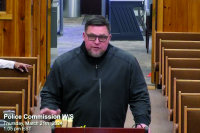O’Connor’s life and characters
Two weeks ago, a friend and I traveled down into Central Georgia looking for Flannery O’Connor.
My friend, whom I will dub Lucky for this piece, had never heard of Flannery O’Connor nor read anything written by her. She didn’t know Hazel Motes from a hole in the ground and assured me she had never heard of A Good Man Is Hard To Find or “The Life You Save May Be Your Own.” Lucky’s literary tastes run in a different stream, and she was strictly along for the adventure.
That circumstance notwithstanding, it was Lucky who finally summoned up the spirit of Flannery O’Connor for us. Hence the pseudonym.
We drove down out of the mountains into the rolling hills of Piedmont George to Milledgeville, where O’Connor spent the last 13 years of her short life — she died at 39 of lupus — living with her mother, Regina, on a farm outside of town. Driving from that farm, Andalusia, into town used to mean a three-mile trip through farmland and scruffy pine. Today that same piece of road is a plastic strip of motels, fast food restaurants, shopping malls and outlet stores.
At Andalusia we parked in a dirt and gravel lot behind the house. The managers of the property have retained nearly all the 500-odd acres that the O’Connors had once owned for the beef farm. Surrounded by oak, cedar and walnut trees, the outbuildings around the house were in varying states of repair. It was hot and dusty, and we didn’t trouble to walk to all these buildings, though I was fascinated to see that directly behind the house a small barn lay collapsed with an enormous old iron wash pot upside down in the wreckage. Beside the collapsed barn was the short water tower, painted white, which figures in some of O’Connor’s work. Off to one side of the yard was a coop holding three peacocks — O’Connor was famous for keeping such birds — whose sudden cries startled the air of this quiet place.
The outside of the house, with its large screened-in front porch, its various abutments, and its red and apparently freshly painted tin roof, appeared in good repair. Around one of the second floor windows buzzed a swarm of honey bees, a detail which I felt sure O’Connor would have appreciated.
Related Items
Inside the house were the rooms which I had hoped would evoke in me the spirit of O’Connor’s wonderful writing. Here in the kitchen were the white sink, stove, and cabinets so prevalent in the South in the first half of the 20th century. Here was the Hot-Air Refrigerator, which Flannery had bought for her mother with the television proceeds of “The Life You Save May Be Your Own.” Here was a small gift shop selling O’Connor’s books as well as some tourist items: coffee cups, pens, cards. Mark Jurgensen, who was operating the shop and the tours that day, spoke for five minutes or so about O’Connor’s life at Andalusia and how she had written most of her important work here.
O’Connor’s lupus made getting around troublesome, and so she lived at the front of the house in the room that would typically be the parlor. Here, looking at the bare room with its faded carpet, its typewriter and desk, the crutches leaning against a plain dresser, the tidy single bed, the cracked and peeling paint of the walls (the foundation needs more money to make these repairs), I could almost feel her presence.
But something was still missing. It was missing when we later visited the little Flannery O’Connor museum in town. It was missing when we stood at her grave in Memory Hill Cemetery; it was missing when we took the trolley tour of Milledgeville; it was missing when we attended Mass in Sacred Heart Catholic Church, sitting just a few pews back from where Regina and Flannery had once sat.
Mostly, I realized, what was missing were O’Connor’s people, the characters of her short stories and novels. I couldn’t find them in the motels and restaurants of the strip. Our trolley tour guide, a most excellent raconteur, was a retiree from Pittsburg. Of the parishioners in the Catholic Church, only two were native Georgians (I know this statistic because the visiting priest, who hailed from Michigan, made a joke about Yankee invaders and was told of the two lone Georgians in the parish).
As we drove back toward Commerce, where we would pick up I-85, Lucky pointed out a hand-painted sign advertising “J&J Flea Market, Georgia’s Largest.” I had promised her some shopping in return for enduring my literary ambles, and so we swung down a dirt road past a pretty lake into an enormous collection of booths, more dirt roads, and shoppers and vendors.
And here they were, O‘Connor‘s people, all country people, all out to make a buck selling junk on this hot afternoon. Here were whites, blacks and Hispanics, tattooed, sweaty rednecks of all hues selling and buying used tools, old clothes, jewelry, baseball caps, lawnmowers, DVDs, watermelons and tomatoes. Here was the Flea Market Trolley, hauling folks from one bare table emporium to the next; here was the Dust-Buster, a broken-down old truck dribbling water out its rear end to keep the dirt still. Here, in short, were the people climbing first into heaven as seen by the middle-class Mrs. Turpin in “Revelation” — “whole companies of white trash ... and battalions of freaks and lunatics shouting and clapping and leaping like frogs.”
So they’re still out there in the Georgia hills, those country people O’Connor used so often in her stories and somehow knew so well. “This place is Jerusalem to me,” a Massachusetts man said to Lucky during our walk around Andalusia. “I’ve read everything she ever wrote and everything written about her.” Well, Andalusia is no doubt Jerusalem for O‘Connor aficionados, but her characters — and some of her spirit as well — live on at J & J’s Flea Market out on Highway 441.













